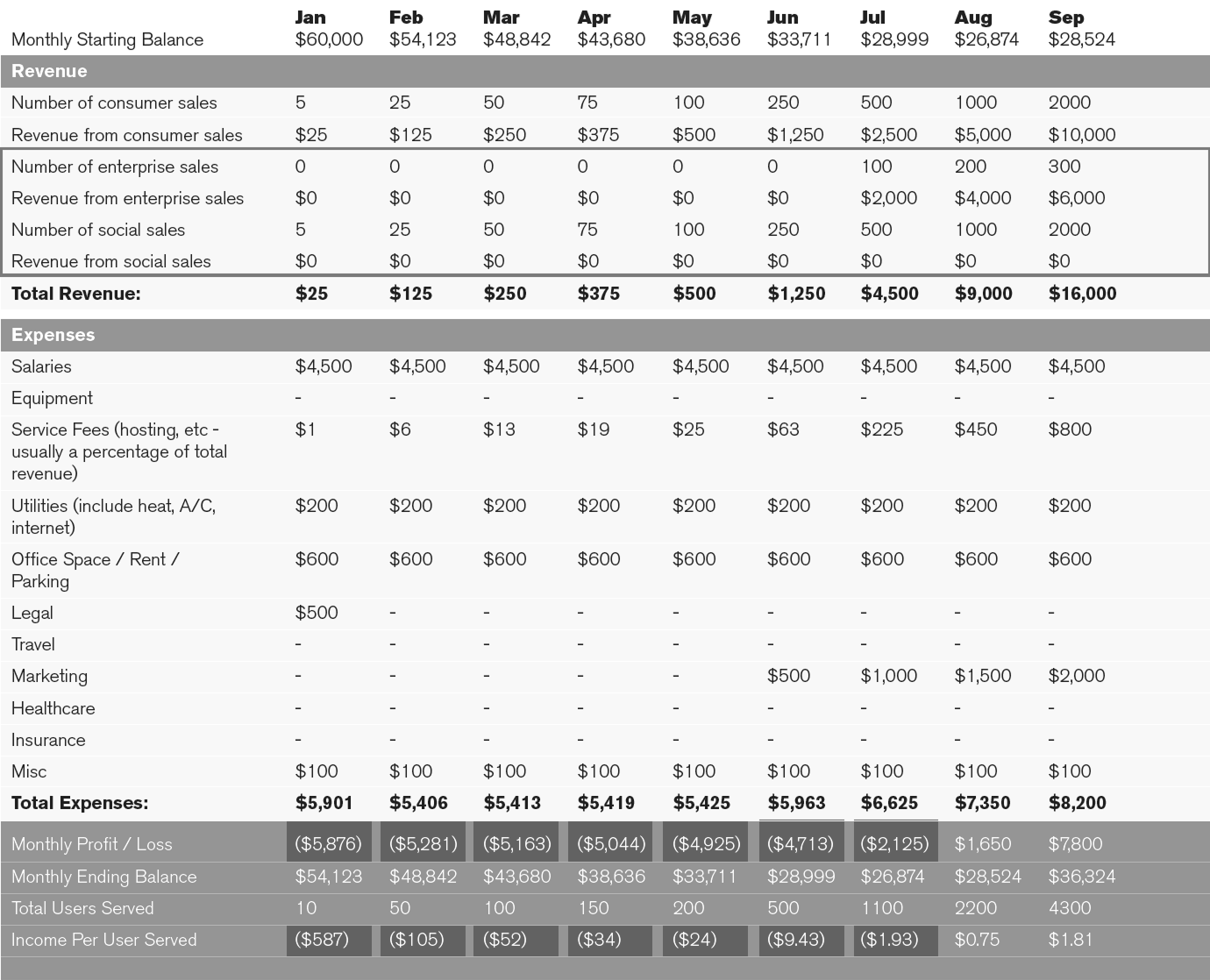You are reading the book Wicked Problems, published by Jon Kolko in 2011.
Methods for Planning a Business
Triple-tiered Subsidy Worksheet
What is it?
A triple-tiered subsidy worksheet extends the Revenue and Expense Worksheet (previously described) to include basic financial information related to additional revenue streams. A combined focus on profitability and social impact often implies that a given service's users are not the same as its payers. So the payers often subsidize the service to nonpaying users. This subsidy can take many forms; one example is the three-tiered approach, where social entrepreneurs offer a free product, a product targeted at paying consumers, and a product targeted at large businesses, all leveraging the same core design innovation.
For example:

In this model, entrepreneurs may create a service providing immense social value, and give it away to those in need. This is the first tier of the model—the "social purchase." It's a purchase that is subsidized—the product is offered at low cost or for free to people who meet certain requirements. This may be the best way to get the product into an NGO or a nonprofit or to influence decisions within local government or supporting agencies.
Simultaneously, entrepreneurs may supplement, augment, or redirect the product or service for sale to "regular" paying consumers. This is the second tier of the model. The internet makes it easy to target consumers, and the sheer quantity of consumers may tempt you to reach out to this group as a main audience.
The third tier of the model provides the major financial base, as it targets the enterprise. "Enterprise" typically refers to large institutions that can distribute the product to thousands of users, often paying on a per-user model. "Enterprise customers" generally implies a medium or large-size business that buys a software product, on a monthly basis, for staff members. A company may purchase 100 "seats" of a product, meaning that 100 different people can use the product at any given time. An enterprise customer has different needs than a commercial consumer, and you'll want to leverage these differences:
- Decision-makers in an enterprise sale are often not end users. They may be in purchasing, information technology, or human resources.
- The amount of time it takes to sell software or service is much longer when engaging with an enterprise customer. An enterprise sales cycle can last six months or a year. That's often because more people need to be involved in the decision-making process, and the purchasers may not have the budgetary authority to sign off on the purchase themselves.
- The amount of money spent in an enterprise sale is much larger than in a consumer sale. At one time, an enterprise may purchase 1000 seats of a piece of software, at $10/seat/month.
When used successfully, the triple-tiered subsidy model provides the following benefits:
- Large, enterprise customers provide the bulk of incoming revenue.
- Consumer purchases create less revenue but more volume, so they increase the awareness of your company
- Both enterprise and consumer purchases subsidize your ability to provide the product for free to people who cannot afford it.
But the model also presents challenges. Perhaps the biggest one is this: To implement a three-tiered subsidy model, a product needs to offer a single platform-based value proposition across all three audiences, yet retain a common core.
How do I do it?
Fill out the revenue and expense worksheet as described above. But in addition to defining and predicting market sizes and expectations for consumer behavior, also do so for enterprise and social purchases. Consider that both groups will require much more time and attention, so appropriately plan your staffing needs and selling time.
Note that the example above makes the following assumptions:
- 3 employees, each making $1,500 per month, have each contributed $20,000 in seed funding
- There are no equipment costs
- A service is offered at $5 per month, per customer
- The total market size is 250,000 people
- During June, 5% of that market size is reached through advertising (12,500 people), and 2% of those reached through advertising transact (250 people)
- Enterprise service is offered at the same price, $5 per month, per user
- Separate (additional) marketing efforts are required to attract enterprise customers
- "Social sales" describe the subsidized population
When should I use it?
Use the triple-tiered subsidy worksheet when you have a core product offering that can easily extend into the enterprise or a nonprofit context. For example, if you've developed financial-management software for individuals, slightly different features and price points may make it easily extend to helping businesses do the same.
What is the output, and how can I use it?
The output is a digital worksheet that can be easily changed as your assumptions and business model change. This worksheet results in an understanding and indication of how multiple user groups can be served with the same or similar product offerings at various price points. The model provides insight into the amount of time necessary to achieve the financial and broad impact desired.
Where can I download this worksheet?
You can download this worksheet as an Excel file here.
Where can I learn more?
Learning about subsidies in other contexts can help explain how you might be able to apply them in your business; explore how government subsidies work at www.earthtrack.net/subsidy-primer
